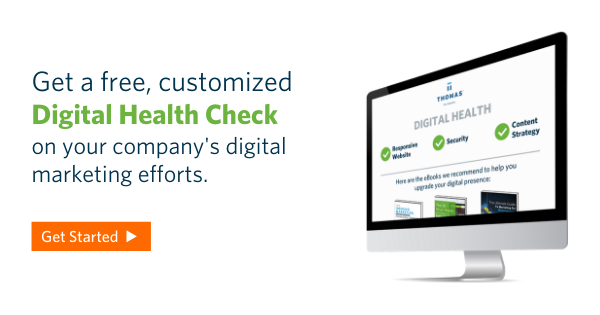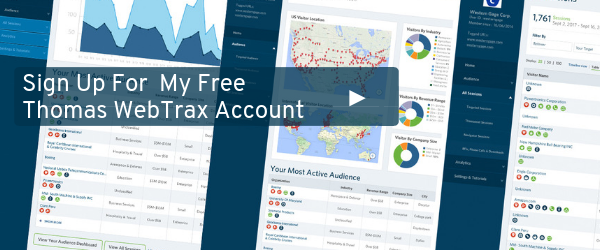Thomas WebTrax: How Industrial Suppliers Can Get More Leads
Team Thomas September 25, 2018
To the casual observer, today’s strong economy and booming manufacturing sector might give the impression that landing new customers in the industrial space is easy. As an industrial supplier, you know better.
Marketing and sales tactics that proved so successful in days past have become obsolete virtually overnight. Today’s industrial buyer has more information at their fingertips than ever before. Long gone are the days when a buyer picks up the phone to contact your sales team at the start of the buying process.
Today’s wealth of online information, and the desire for relative anonymity among millennial (and younger) buyers have them guiding themselves through as much as 70 percent of the buying process before they initiate contact with a supplier. This reality makes it vital that you understand how to connect with and support all buyers at each stage of the buying process — especially during that first 70 percent.
But you have a business to run.
If you’re like many of your peers in the industrial space, you simply don’t have the time to become the expert on all the latest marketing and sales approaches. You understand that leveraging online activity data is important to achieving your marketing and sales goals, but the raw numbers of simple web analytics seem like just that — numbers.
Thomas WebTrax Helps You Overcome Long Sales Cycles
Think about it. You don’t want to analyze things, you want to sell things. Thomas WebTrax lets you go beyond simple web analytics, and start engaging real buyers.
Thomas WebTrax gives you actionable data on buyers that are actively in-market for what you sell. It enables you to track, identify and engage buyers that have signaled a propensity to buy your products and services, by capturing and storing their activity and interaction with your various digital marketing efforts and online content, and presenting that data on one comprehensive and intuitive dashboard. Used effectively, this opportunity intelligence helps you overcome the significant challenges that today’s industrial suppliers face, such as:
- Long sales cycles that can range from months to a year or longer.
- A finite market of customers to sell to.
- Sophisticated, technical buyers with very specific wants and needs.
- Buyers that have more control over their marketing and sales experience than ever before.
A lead generation solution on your website like Thomas WebTrax unites your marketing and sales teams, helping them seamlessly support buyers that are in-market for your products and services, and guide those buyers down the buying process toward the sale. It helps them align their efforts as your business makes the critical shift from sales enablement to buyer enablement.
Understand Today's Industrial Buyers
Successful suppliers are realizing that focusing on sales enablement ignores the reality that today’s industrial buyer conducts the buying process differently than in the past. Today’s buyers don’t want or need to be “sold,” they’re interested in information that helps them do their job, from early in the buying process up to and through the purchase decision.
By no means does this shift from sales enablement to buyer enablement minimize the importance of your sales team; it actually increases its value to your prospects, and in turn, to your business. When your sales team understands exactly what type of information and level of support buyers want and need at each stage of the buying process, they can customize and focus their outreach to resonate with those buyers at every stage of the process.
To that end, Thomas recently partnered with leading research firm Strategyn to conduct one of the largest ever studies into the needs of today’s industrial buyer. We surveyed and interviewed 315 industrial buyers over 45 weeks to determine their specific challenges, wants, needs and concerns as they navigate today’s increasingly complex industrial buying process.
While we distilled our findings into a 6 stage process every industrial buyer goes through…

…our research actually uncovered 15 distinct steps that buyers must take within those 6 stages of the buying process. Those steps look like this:
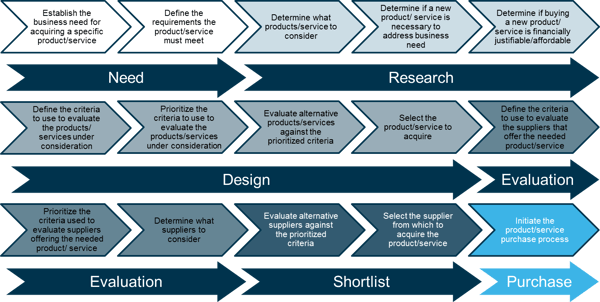
Within those 15 steps, we uncovered 139 different tasks that buyers use to measure success throughout the process. As the saying goes, “time is money,” and the lion’s share of those outcomes begin with the phrase “Minimize the time it takes to….”
For example, here are just a few:
- “Minimize the time it takes to determine the performance related requirements the product/service must meet.”
- “Minimize the time it takes to determine if superior products/services will be available in the near future.”
- “Minimize the time it takes to estimate the likely acquisition cost of the product/service, e.g. purchase price, transportation, warranty, on-boarding, etc.”
As these are just three of the 139 tasks buyers told us they need to consider, it’s clear that the industrial buying process is far more complex than one might expect. The result is that today’s buyer seeks out the specific information and support that aligns with the unique task they’re trying to accomplish at that moment within their greater buying journey. They don’t want a sales pitch. They want you to help them do their job.
Sell The Way Today’s Buyer Buys
When you’re able to see how a buyer is engaging with your online content from their first ‘anonymous’ touch up through real-time, you’re able to align your marketing and sales efforts with the way that buyer wants and needs to be supported.
Whether your opportunities are marketing qualified leads (MQLs) early in the buying process, or sales qualified leads (SQLs) closer to the purchase decision, Opportunity Intelligence gives you insight into where they are in the buying process, and what they’re actively interested in. This actionable insight means that you can better target your marketing efforts to support buyers (and generate opportunity) throughout the entire buying process, while evolving your sales team from cold-callers and order-takers to valued buyer-enablers for your prospects.
Uncover High Quality Leads Thomas WebTrax™ 3.0
Thomas WebTrax 3.0 lets you track, identify and engage buyers at all stages of their buying process — even before they’ve contacted you. It provides is actionable data on buyers that are actively in-market for the products or services you offer, making it possible for your marketing and sales teams to connect with and enable those buyers effectively — no matter how far along they are in the buying process.
Track your opportunities.
Whether buyers are visiting your industrial website or your Thomasnet.com presence, viewing your eCatalogs, downloading your CAD/BIM files, or even calling you by phone, Thomas WebTrax captures and stores detailed data on their activity, and presents it to you on one intuitive dashboard. Rather than provide simple “how many” analytics on the virtually meaningless metrics of traffic, clicks and visits, Thomas WebTrax helps you focus on who is interacting with your online presence, what they’re interested in, and how far along they are in their buying process. And because engaging real buyers is important, The Thomas WebTrax platform strips out the worthless bot activity that so often inflates the numbers you see in simple web analytics.
Identify your opportunities.
Thomas WebTrax offers advanced filtering features that enable you to prioritize the highest value opportunities for your marketing team to nurture, and your sales team to pursue. You can specify criteria such as industry, location, company size, and revenue range, then easily isolate and view the activity of buyers that meet those exact specifications. You can also specify the highest value pages from among all of your online content. All filters and settings are easily adjustable, so you can ensure that the high-value opportunities you identify are always aligned with your evolving sales priorities and business goals.
Engage your opportunities.
Once you’ve identified your high-value opportunities, the Opportunity Intelligence delivered by Thomas WebTrax enables your marketing and sales teams to engage and enable those in-market buyers like never before. By understanding where the buyer is along their buying journey, and by having insight into what they’re interested in, your marketing tactics and sales outreach calls can align precisely with what the buyer wants and needs at every stage throughout that journey. With the ability to feed your Thomasnet.com RFIs directly into your marketing automation system, Thomas WebTrax is an ideal solution for keeping your pipeline full and your sales team motivated.
The Industrial Buying Process
Based on our in-depth research and our 120-year focus on serving the industrial buyer, Thomas can recommend how to communicate with, enable and engage buyers from the earliest stage of the buying cycle, through to the purchase decision. As you act upon your Opportunity Intelligence, the key thing to remember is to enable the buyer. Depending upon which stage of the buying process they are in, the information and support they’re looking for varies significantly. When you enable and engage buyers effectively at each stage of the buying process, you guide and advance them through that process while standing out from your competition.
Enable and engage buyers in the Need stage.
In this nascent stage of the industrial buying process, buyers passively yet consciously try to stay aware of the products and services that are available to meet the evolving needs of their business.
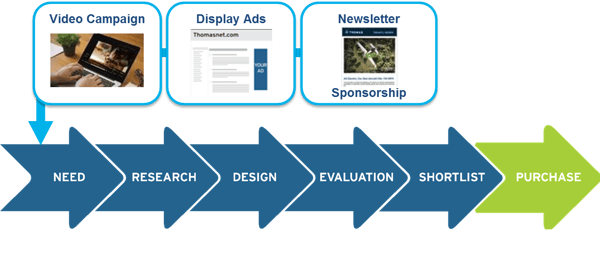 Targeting buyers with the appropriate marketing tools in this stage can often create a need that the buyer previously hadn’t considered, while also generating actionable Opportunity Intelligence for your marketing and sales teams.
Targeting buyers with the appropriate marketing tools in this stage can often create a need that the buyer previously hadn’t considered, while also generating actionable Opportunity Intelligence for your marketing and sales teams.
Effective marketing tactics in this stage of the buying process include brand-building vehicles such as Video Campaigns, Display Advertising, Advertorials/Sponsored Content, and Newsletters — many of which can drive to downloadable content for which the buyer will readily provide their email address. This is early and actionable Opportunity Intelligence for you.
Engaging buyers effectively at this stage can be done through an email nurturing campaign that promotes content that’s typical to the next stage (Research) of the buying cycle, such as your eBooks and White Papers.
If you have a proactive sales team that is interested in building long-term relationships, engaging the buyer with an outreach call at this stage is not out of the question. Keeping in mind that the goal is to enable rather than to “sell,” such an outreach call may go something like this:
“Hi Jane, this is Mike from ABC Company. We work with a number of companies in your line of business, and a lot of them rely heavily on DC motors. With all the options and considerations it can be tricky to hone in on the right solution. If DC motors are something you source on occasion, I just wanted to let you know I’m available to help. I’ve been helping people in your position understand what’s available and appropriate for different situations for the past 15 years, so if you ever want some guidance on a specific application, I’d be happy to provide it.”
Enable and engage buyers in the Research stage.
Once buyers have established that they have a need, they begin to actively research and educate themselves on the solutions that are available in the market.
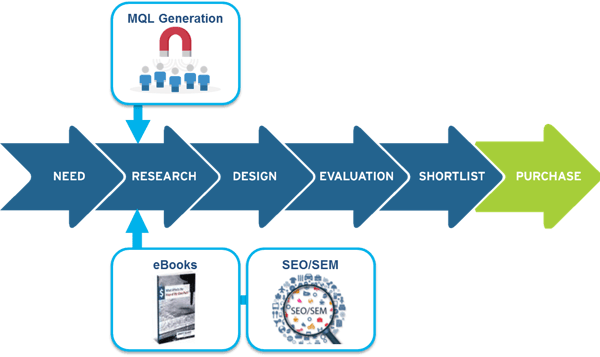
These buyers are hungry for information. Marketing tactics that enable them at this stage — while generating Opportunity Intelligence for you — include drivers to your website such as SEO programs and Pay-Per-Click campaigns. You can also implement email and Pay-Per-Lead campaigns leveraging your eBooks and White Papers.
Effective enablement at any stage of the buying process drives the buyer forward to the next stage in that process. So, enabling buyers here in the Research stage is done through marketing that delivers content they might seek in the subsequent Design and Evaluation stages of the buying process. Email nurturing campaigns are effective here, delivering content such as CAD/BIM files, Product Data, and information on your company’s Services and Capabilities.
Sales engagement at the Research stage should support the buyer in understanding the ins-and-outs of the specific product or service they’re researching. Let’s say the buyer downloaded your eBook on different edge types available in deep drawn stamping. A helpful and welcome outreach call might go something like this:
“Hi Fred, this is Mike from ABC Company. My marketing team let me know that you might need some help in understanding the different edge types that are available with deep drawn stamping. I know it can be confusing to determine the right edge for a specific application, I’ve been helping customers figure out the pros and cons of the different options for 15 years, so if I can be of any assistance as you work through this part of your process, you can give me a call at any time. You can reach me at….”
Sales can also effectively engage buyers via email nurturing at this stage. Creating reusable email templates can save a lot of time; a suggested three-email (one per week) cadence here might present the following content:
- Downloadable eBooks or white papers
- Links to relevant/helpful pages on your website
- Information on custom options
Enable and engage buyers in the Design stage.
Buyers in the Design stage of the buying process are typically design engineers that are designing a prototype or high-volume component/assembly/product for an active project. They are looking for product data that will help them spec the right form/fit/function solution into their design.

In the Design stage, marketing tactics that enable buyers — and generate Opportunity Intelligence — include downloadable or interactive content such as CAD/BIM models, Product Data, Technical Data Sheets, Configuration Tools, and Calculators. If you’re an OEM or distributor, our data shows that CAD/BIM models are the highest value lead conversion asset out of all your marketing and product content. If you’re a service provider, case studies and overviews of the different types of projects you’ve worked on are valuable in this stage.
Engaging buyers in the Design stage calls for connecting them with content from the subsequent Evaluation and Shortlist stages of the buying process. Retargeting and Email Nurturing campaigns that drive to specific pages on your website or to your content on Thomasnet.com are helpful here.

As in the Research stage, effective sales engagement in the Design stage helps the buyer gain a deeper understanding of the specific solution being considered. Up to 88% of businesses ultimately buy the part after downloading the CAD model — learn more here.
For example, let’s say your Opportunity Intelligence shows that a design engineer from Schlumberger downloaded your CAD model for a 3-way lateral ball valve. A helpful and effective outreach call could go as follows:
“Hi Mark, this is Mike from ABC Company. I noticed you downloaded a CAD model for one of our 3-way lateral ball valves. I just wanted to make sure you got all the information you needed. In large organizations like yours I know the internal sourcing process can be pretty complex, and procurement can have a lot of different requirements for you guys in engineering. I’ve worked through it a ton of times with engineers at large organizations over the past 15 years, and I’m happy to help you put together the specific information your procurement team needs from you as they go through the process.”
A three-email nurturing track from sales in the Design stage could include emails delivering:
- Downloadable CAD/BIM models
- Product data
- Performance test data
Enable and engage buyers in the Evaluation stage.
Buyers in the Evaluation stage of the buying process are actively comparing the products or services available to meet their need, and/or comparing the suppliers that can provide them. In this stage they’re looking for information that assists them in narrowing the choices down to a shortlist of the best possible solutions. This stage may be the first time in the entire buying process that the buyer actively reaches out to you (or your competitors) with a phone call or RFI.
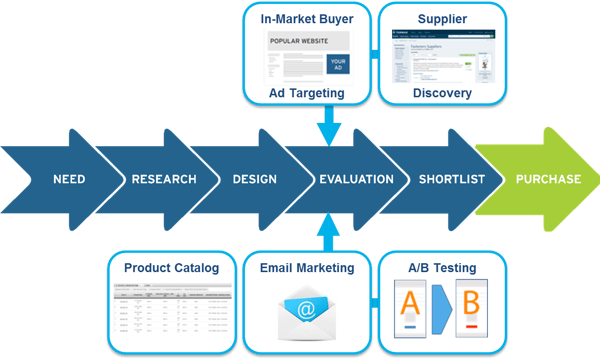
Marketing tactics such as Email Nurturing , A/B Testing of Website Pages and In-Market Buyer Retargeting can generate Opportunity Intelligence on in-market buyers that are in the Evaluation stage. Relevant information at this stage includes such things as product comparisons across brands, replacement part number data for competitors’ products, and detailed company info such as that available in your Thomasnet.com Company Profile. (Create your free company profile here if you don't have one and start engaging with more buyers.)
Engaging and helping to advance buyers in the Evaluation stage calls for providing content they’ll need in the subsequent Shortlist stage of the buying process. Relevant information here includes things such as your product case studies, service success stories, supplier performance data and history, and certifications. The ideal goal of your marketing efforts at this stage is to have the buyer schedule a consultation with sales.
Buyers in the Evaluation stage are high-value opportunities for your sales team. Engagement calls here should provide information that helps the buyer understand the positive impact of selecting your product or service, and the support they will get from you as a part of their supply chain. Let’s say your company received an RFI for your powder coating services. A helpful outreach call at this stage could go something like this:
“Hello Grace, this is Mike from ABC Company. We received your RFI related to our powder coating capabilities and we’re putting together the information you asked for, I’ll send that over before the end of the day. I’ll also send over some case studies on projects we’ve done for customers in your industry – they might bring up some important factors you haven’t considered. In addition to that, is there any information not requested in your RFI that would be helpful to you at this point? Perhaps we can talk for 20 minutes to see if I can help.”
An effective email nurturing track from sales at this stage might include emails that:
- Request a discovery call with the buyer
- Present helpful info such as your company’s on-time delivery rate
- Outline payment term options
Enable and engage buyers in the Shortlist stage.
Buyers that have reached the Shortlist stage of the buying process have contacted the suppliers on that list, typically with an RFP or RFQ. At this stage, buyers are looking for information that will reassure them that the supplier they ultimately choose will be the right decision. Choosing the wrong product or supplier can be disastrous not only for the buyer’s company, but for the buyer’s career, so there’s typically a lot on the line when making the final decision on selecting a supplier for a large purchase.

Marketing tactics to generate Opportunity Intelligence that identifies buyers in the Shortlist stage of the buying process would include vehicles such as your website or Thomasnet.com Company Profile, or other tactics where the buyer engages with content such as product case studies, service success stories, certifications documentation, your company locations information, and your supplier performance data and history.
Effectively engaging buyers in the Shortlist stage calls for providing content that helps differentiate your company from the competition, and drives the buyer toward choosing you as their supplier. This can be information including RFP/RFQ support, certification documentation, financial/credit information, and business ownership/diversity designation documentation.
Trending Now: What Industrial Buyers Care Most About When Shortlisting New Suppliers
Being helpful to the buyer at this stage means not only acknowledging that you received the RFP/RFQ (which a surprising percentage of suppliers never do, according to buyers in our study), but providing that reassurance they’re looking for by reaching out to them with information beyond what they requested in the RFP/RFQ. An outreach call here is not only welcome, but often expected, and might sound something like this:
“Hi Phyllis, this is Mike from ABC Company. Just calling to let you know that we received your RFQ and we’re working on it now. Thank you, we appreciate you sending it and we’re looking forward to the opportunity to become part of your supply chain. Beyond the pricing and specs information you asked for, I’ll send over some info on our on-time delivery rate, our technical support, and a list of customers we’ve done projects for in your industry. If there’s anything else you’d like to know about us as you go through the process, please call me directly at….”
Buyers will typically expect a higher level of sales engagement at this stage, and a nurturing track here might include emails that:
- Request an engineering meeting
- Review your pricing
- Provide RFP/RFQ support
- Provide certification documentation
- Provide financial/credit information on your company
- Provide business ownership/diversity designation documentation
- Provide all documentation required to add you to the supply chain as an approved vendor
- Invite the buyer to an in-person meeting and facility tour
Enable and engage buyers that have made the Purchase.
Effective buyer enablement doesn’t end at the sale. You want long-term customers that do business with you again and again. You also want those customers to share positive stories about their experience with you to other prospects, ideally through referrals.
Enabling and engaging your customers after the sale can take many forms beyond any ongoing service and support that may be part of your contract. There are many marketing tactics that can be both effective and welcome. Provide news on your company, perhaps through your newsletter. Share industry news and info that might be relevant to your customer. Provide information that educates your customer on new products and services, or makes them aware of new certifications your company has earned. Celebrate and congratulate your customers’ news and achievements on your company’s social media channels.
Your sales team is also key to engaging your customers after the sale. They can foster trust and build long-term relationships by doing such things as calling to review product and delivery performance metrics, or inquiring about new projects your business might be able to support. At a minimum, your sales representative should try to have quarterly discussions with the customer, ideally face to face.
Get More Leads That Only Thomas Solutions Can Offer
If you’re ready to go beyond simple web analytics and start engaging real buyers, put Opportunity Intelligence to work for your business. Thomas WebTrax bridges the gap between marketing and sales, giving them actionable data on in-market buyers throughout the entire buying process. It helps your company make the critical shift from sales enablement to buyer enablement, and “sell” the way today’s buyer buys.
Thomas WebTrax is free to qualifying companies; visit Thomasnet.com/WebTrax to get your team started today.
Did you find this useful?



